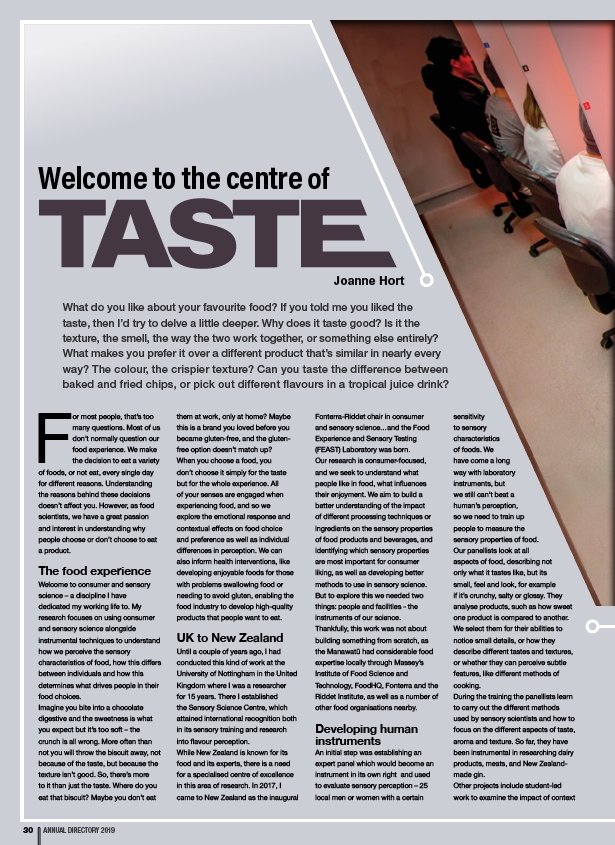
For most people, that’s too
many questions. Most of us
don’t normally question our
food experience. We make
the decision to eat a variety
of foods, or not eat, every single day
for different reasons. Understanding
the reasons behind these decisions
doesn’t affect you. However, as food
scientists, we have a great passion
and interest in understanding why
people choose or don’t choose to eat
a product.
The food experience
Welcome to consumer and sensory
science – a discipline I have
dedicated my working life to. My
research focuses on using consumer
and sensory science alongside
instrumental techniques to understand
how we perceive the sensory
characteristics of food, how this differs
between individuals and how this
determines what drives people in their
food choices.
Imagine you bite into a chocolate
digestive and the sweetness is what
you expect but it’s too soft – the
crunch is all wrong. More often than
not you will throw the biscuit away, not
because of the taste, but because the
texture isn’t good. So, there’s more
to it than just the taste. Where do you
eat that biscuit? Maybe you don’t eat
them at work, only at home? Maybe
this is a brand you loved before you
became gluten-free, and the glutenfree
option doesn’t match up?
When you choose a food, you
don’t choose it simply for the taste
but for the whole experience. All
of your senses are engaged when
experiencing food, and so we
explore the emotional response and
contextual effects on food choice
and preference as well as individual
differences in perception. We can
also inform health interventions, like
developing enjoyable foods for those
with problems swallowing food or
needing to avoid gluten, enabling the
food industry to develop high-quality
products that people want to eat.
UK to New Zealand
Until a couple of years ago, I had
conducted this kind of work at the
University of Nottingham in the United
Kingdom where I was a researcher
for 15 years. There I established
the Sensory Science Centre, which
attained international recognition both
in its sensory training and research
into flavour perception.
While New Zealand is known for its
food and its experts, there is a need
for a specialised centre of excellence
in this area of research. In 2017, I
came to New Zealand as the inaugural
Fonterra-Riddet chair in consumer
and sensory science…and the Food
Experience and Sensory Testing
(FEAST) Laboratory was born.
Our research is consumer-focused,
and we seek to understand what
people like in food, what influences
their enjoyment. We aim to build a
better understanding of the impact
of different processing techniques or
ingredients on the sensory properties
of food products and beverages, and
identifying which sensory properties
are most important for consumer
liking, as well as developing better
methods to use in sensory science.
But to explore this we needed two
things: people and facilities - the
instruments of our science.
Thankfully, this work was not about
building something from scratch, as
the Manawatū had considerable food
expertise locally through Massey’s
Institute of Food Science and
Technology, FoodHQ, Fonterra and the
Riddet Institute, as well as a number of
other food organisations nearby.
Developing human
instruments
An initial step was establishing an
expert panel which would become an
instrument in its own right and used
to evaluate sensory perception – 25
local men or women with a certain
sensitivity
to sensory
characteristics
of foods. We
have come a long
way with laboratory
instruments, but
we still can’t beat a
human’s perception,
so we need to train up
people to measure the
sensory properties of food.
Our panellists look at all
aspects of food, describing not
only what it tastes like, but its
smell, feel and look, for example
if it’s crunchy, salty or glossy. They
analyse products, such as how sweet
one product is compared to another.
We select them for their abilities to
notice small details, or how they
describe different tastes and textures,
or whether they can perceive subtle
features, like different methods of
cooking.
During the training the panellists learn
to carry out the different methods
used by sensory scientists and how to
focus on the different aspects of taste,
aroma and texture. So far, they have
been instrumental in researching dairy
products, meats, and New Zealandmade
gin.
Other projects include student-led
work to examine the impact of context
Welcome to the centre of
Joanne Hort
What do you like about your favourite food? If you told me you liked the
taste, then I’d try to delve a little deeper. Why does it taste good? Is it the
texture, the smell, the way the two work together, or something else entirely?
What makes you prefer it over a different product that’s similar in nearly every
way? The colour, the crispier texture? Can you taste the difference between
baked and fried chips, or pick out different flavours in a tropical juice drink?
30 ANNUAL DIRECTORY 2019